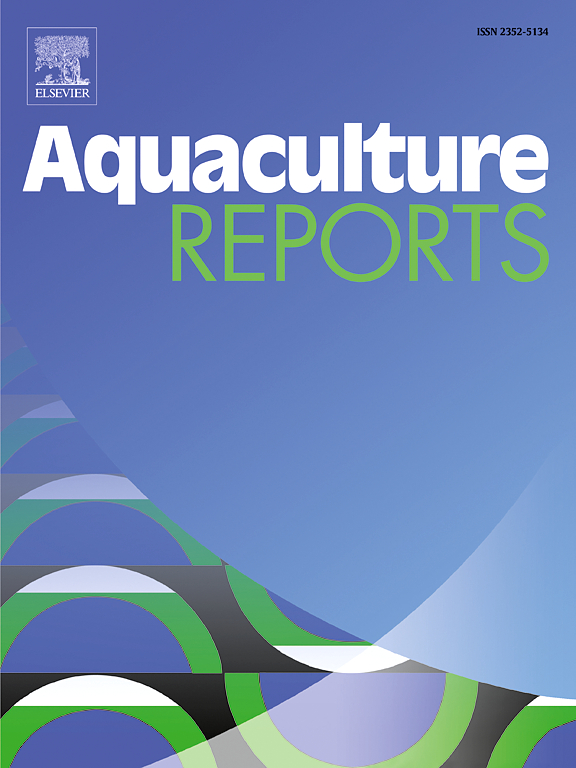Wheat flour as carbon source on water quality, growth performance, hemolymph biochemical and immune parameters of Pacific white shrimp (Penaeus vannamei) juveniles in biofloc technology (BFT)
IF 3.2
2区 农林科学
Q1 FISHERIES
引用次数: 0
Abstract
This study examined how adding wheat flour (relative to daily feed) affected water quality, growth performance, body composition, hemolymph biochemical and immunity activities of Penaeus vannamei. In 5 experimental enclosures, pacific white shrimp juveniles weighing an average of 2.80 g were reared for 49 days at a density of 1 g/L. The experimental groups include a control group (without wheat flour, 35–50 %/day water exchange) and four biofloc treatments containing wheat flour in proportions of 25 % (WF25), 50 % (WF50), 75 % (WF75) and 100 % (WF100) of daily feed added in the water. The method of feeding and the type of feed was the same in all treatments. In the control group, the highest amounts of total ammonium nitrogen (TAN) (1.14 mg/L), nitrite (8.15 mg/L), and nitrate (3.60 mg/L) were observed (P < 0.05). In biofloc WF50 and WF75 treatments, the highest body weight (9.09–9.18 g), feed efficiency (74.11–74.68 %) and survival rate (93.20–93.83 %) were obtained (P < 0.05). Adding wheat flour to the rearing system improved the biochemical composition of shrimp bodies, so that the control group had the lowest level of protein (75.31 % DW), lipid (6.81 % DW), and ash (11.48 % DW) (P < 0.05). With wheat flour added to the rearing system, shrimp hemolymph glucose and triglyceride levels increased, and the highest levels of glucose were obtained in treatments WF50 (41.33 mg/dL) and WF75 (42.0 mg/dL). Adding wheat flour to the rearing system increased shrimp hemolymph immune activity. The control group exhibited the lowest levels of lysozyme (19 u/mL/min) and phenoloxidase (0.41 u/mL). The results demonstrated that by adding wheat flour to the biofloc cultivation system (under the conditions of this study) in the amount of 50–75 % of the daily feed ration, the water quality, growth performance, feed efficiency, survival rate, hemolymph biochemical, and immunity activities of P. vannamei improved.
求助全文
约1分钟内获得全文
求助全文
来源期刊

Aquaculture Reports
Agricultural and Biological Sciences-Animal Science and Zoology
CiteScore
5.90
自引率
8.10%
发文量
469
审稿时长
77 days
期刊介绍:
Aquaculture Reports will publish original research papers and reviews documenting outstanding science with a regional context and focus, answering the need for high quality information on novel species, systems and regions in emerging areas of aquaculture research and development, such as integrated multi-trophic aquaculture, urban aquaculture, ornamental, unfed aquaculture, offshore aquaculture and others. Papers having industry research as priority and encompassing product development research or current industry practice are encouraged.
 求助内容:
求助内容: 应助结果提醒方式:
应助结果提醒方式:


